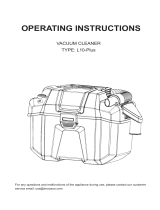
17 ESPAÑOL
6.
No manipule el aparato con las
manos mojadas.
7. No introduzca ningún objeto en las
aberturas. No lo utilice con ninguna
abertura bloqueada; manténgalo
libre de polvo, pelusa, cabello y
cualquier objeto que pueda reducir
el ujo de aire.
8.
Mantenga el cabello, la ropa holgada,
los dedos y todas las partes del cuerpo
lejos de las aberturas y piezas móviles.
9. Apague todos los controles antes
de retirar el cartucho de batería.
10. Tenga especial cuidado cuando lim-
pie en escaleras.
11. No lo utilice para recoger líquidos
inamables o combustibles, tal
como gasolina, ni en áreas donde
puedan estar presentes.
12.
No recoja nada que se esté que-
mando o desprenda humo, tal como
cigarros, fósforos o cenizas calientes.
13.
No lo utilice sin la bolsa recolectora de
polvo y/o los ltros colocados en su lugar.
14. No cargue la batería en exteriores.
15. Evite una puesta en marcha acci-
dental. Asegúrese de que el inte-
rruptor esté en la posición apagada
antes de conectar el paquete de
baterías, levantar el aparato o car-
garlo. Cargar el aparato con su dedo
en el interruptor o pasar energía al
aparato con el interruptor encendido
puedo propiciar accidentes.
16.
Desconecte el paquete de baterías
del aparato antes de hacer cualquier
ajuste, cambiar accesorios o almacenar
el aparato. Estas medidas de seguridad
preventivas reducen el riesgo de poner en
marcha el aparato accidentalmente.
17. Recargue sólo con el cargador
especicado por el fabricante. Un
cargador que es adecuado para un
solo tipo de paquete de baterías puede
generar riesgo de incendio al ser utili-
zado con otro paquete de baterías.
18.
Use los aparatos únicamente con
los paquetes de baterías designados
especícamente para ellos. El uso
de otros paquetes de baterías puede
generar riesgo de lesiones e incendio.
19.
Cuando no se esté usando el paquete
de baterías, guárdelo lejos de otros
objetos metálicos tales como sujeta-
papeles (clips), monedas, llaves, cla-
vos, tornillos u otros objetos metá-
licos pequeños que puedan crear
una conexión entre una terminal y
otra. Ocasionar un cortocircuito en las
terminales de la batería puede provocar
quemaduras o incendios.
20.
En condiciones de mal uso, podría
escapar líquido de la batería; evite
tocarlo. Si lo toca accidentalmente,
enjuague con agua. Si el líquido entra
en contacto con los ojos, solicite
adicionalmente atención médica. El
líquido expulsado de la batería puede
causar irritación o quemaduras.
21.
No utilice un paquete de baterías o
aparato que esté dañado o haya sido
modicado. Las baterías dañadas o
modicadas podrían comportarse de
manera impredecible causando un
incendio, explosión o riesgo de lesión.
22. No exponga un paquete de baterías
o aparato al fuego o a una tempe-
ratura excesiva. La exposición al
fuego a una temperatura superior a
130 °C podría causar una explosión.
23. Siga todas las instrucciones rela-
tivas a la carga y no cargue el
paquete de baterías o el aparato
fuera del rango de temperatura
especicado en las instrucciones.
Cargar de manera inapropiada o a
temperaturas fuera del rango especi-
cado podría dañar la batería e incre-
mentar el riesgo de incendio.
24. Pida que el servicio lo realice un
técnico en reparaciones calicado
y que utilice únicamente piezas de
repuesto idénticas a las originales.
Esto garantizará que se mantenga la
seguridad del producto.
25. No modique ni intente reparar el
aparato ni el paquete de baterías
salvo como se indique en las ins-
trucciones para el uso y cuidado.
GUARDE ESTAS
INSTRUCCIONES.




















